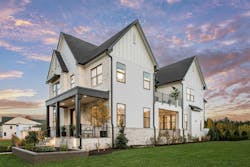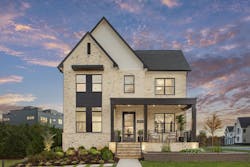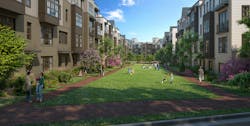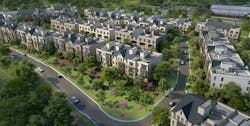Built Outdoor Spaces: The Post Pandemic Trend That's Here to Stay
Key Takeaways
- Built outdoor spaces should be thoughtfully integrated into the designs of a home
- Consumers appreciate built outdoor spaces as places to work and entertain guests in a health-conscious way
- In a recent survey, 89% of residential designers felt that outdoor spaces were as or more important this year than they were in 2024
During the height of the pandemic, my team worked on a variety of projects, running the gamut from large high-end single-family homes to small townhomes targeted toward first-time homeowners. And throughout the industry we discussed how the circumstances of the pandemic were shaping the homes we designed.
The most obvious impact was that we were designing more work-from-home spaces across all home types. But on reflection, did any other trends emerge from this unique time?
One lasting trend is a reconfiguration of outdoor space. No longer are yards or simple decks and patios sufficient, but covered outdoor spaces, balconies and porches and rooftop terraces all emerged as features prized by homeowners and builders alike.
What makes these features valuable is how they blend with the architecture of the community, add value to homes and provide residents with ways to enjoy the outdoors.
In 2025 and beyond, architects, homebuilders and homeowners should expect built outdoor spaces to be thoughtfully integrated into the designs of their homes.
Outdoor Space Matters
A 2021 survey of homeowners by John Burns Research & Consulting (JBREC) found that two out of three respondents reported that outdoor spaces mattered more in post-pandemic times than they did pre-pandemic. At the time, respondents said that they appreciated built outdoor spaces as a place to work and entertain guests in a health-conscious way.
One of my favorite projects at the time, Florin at Amalyn by Toll Brothers (above), featured a covered outdoor deck or concrete patio that became a standard feature for the community. These spaces fit into the architecture of the home by using the same materials as the rest of the exterior; as a result, they look like an integrated feature when viewed from the sidewalk, street or alley.
These spaces also feel like a thoughtful extension of the interior when located off great rooms, dining areas, and kitchens. When possible, they can be multi-story, offering additional outdoor space from the primary bedroom. Multi-slide stacked doors, outdoor fireplaces, built-in grills, pavers and screens are possible upgrades that resonate with buyers.
Built spaces like these have persisted since 2021, and they set the standard for what builders and homeowners have come to expect from their outdoor spaces today.
Growing In Popularity
In 2025, JBREC surveyed designers from the industry who reported that built outdoor spaces are 47% more important than the previous year, more than any other space in the home. Another 42% said that outdoor spaces are just as important now as they were last year.
According to the report, residential designers increased the connection of the home to the outdoors through a variety of features, even carving outdoor spaces into the footprint of the home.
Several of KTGY’s communities from the past few years, including The Aire at Westchester Commons by HHHunt (above), have placed emphasis on front porches and other front-facing balcony features.
These spaces enhance front elevations and often face public green spaces. The home aesthetics benefit from these features, and the green spaces are injected with vibrant activity as neighbors are more likely to engage with each other outside.
On the East Coast, perhaps the biggest trend we see in outdoor spaces is the rooftop terrace. Pitched roofs are traditional for our region, but flat roofs are becoming more popular as density has increased in suburban areas.
In communities where lot sizes are small, where driveways occupy larger percentages of what otherwise would be used for yards, the rooftop is a great option for designers to create outdoor space.
A rooftop terrace can be covered or uncovered, is often finished with materials that blend with the architecture of the home and can be upgraded with outdoor fireplaces to allow three-season use.
We started seeing a demand for rooftop terraces in the Washington, DC metro area, particularly in locations close to public transit. After showing the design and buyer receptiveness to clients throughout the East Coast, we have taken rooftop terraces to other markets.
These built outdoor features maintain their importance in the post-pandemic era and continue to gain popularity in 2025. Homeowners enjoy these spaces, and home builders appreciate the value that these spaces add. When done thoughtfully, they enhance the architecture of the home and the curb appeal of the neighborhood.
For these reasons, built outdoor spaces are a post-pandemic trend that is here to stay. Architects and homebuilders should continue to consider thoughtful built outdoor spaces to meet the needs of prospective homeowners.
About the Author

Jesse Robeson
Jesse Robeson is a director at KTGY’s Washington, DC location, where he manages client relations, consultant coordination, and permitting processes, and serves as a mentor to younger staff members. He has worked in design, production, and construction administration, managing single family detached, townhome, clubhouse and higher density two-over-two, back-to-back and hybrid projects.



